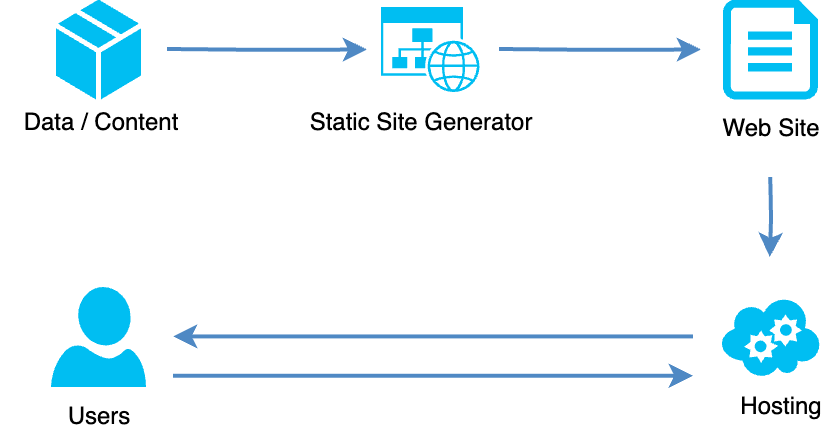Static-Site Generators Explained: Top Tools and How to Deploy on EdgeOne Pages

What is a Static Site Generator (SSG)?
A Static Site Generator (SSG) is a tool that builds websites by generating static HTML, CSS, and JavaScript files from templates, content files, and data sources.
Unlike traditional dynamic websites that generate pages on demand when users request them, static sites are pre-built during the development process, resulting in faster loading times and improved security.
Benefits of Using SSGs
Static Site Generators offer exceptional performance with lightning-fast load times since they serve pre-rendered HTML files. They provide enhanced security through reduced attack vectors, significant cost savings on hosting.
Static site generators use pre-rendering, where all pages are generated at build time. This differs from server-side rendering (SSR), where pages are generated when requested. Pre-rendering offers better performance but requires rebuilding the site when content changes.
Developers enjoy a streamlined workflow with version control integration, while businesses benefit from improved SEO rankings due to consistent performance and structure.
How Static Site Generators Work

SSGs support various content management strategies:
| Strategy | Content |
| File-based | Content stored in Markdown files within the project |
| Headless CMS | External content management systems via APIs |
| Git-based | Content managed through version control systems |
| Hybrid | Combination of multiple content sources |
Most Popular Static Site Generator Frameworks
Next.js - React-based Framework
Next.js is a powerful React framework that supports static site generation alongside server-side rendering. Ideal for marketing sites, e-commerce, and portfolios, it offers automatic code splitting, image optimization, and API routes within the same repository.
// Example Next.js static generation
export async function getStaticProps() {
const posts = await fetchPosts();
return {
props: { posts },
revalidate: 60 // Regenerate every 60 seconds
};
}Gatsby - GraphQL-powered React Generator
Gatsby is a GraphQL-powered React SSG renowned for its rich data sourcing and over 2,500 plugins. It excels at image-heavy blogs, documentation, and headless CMS integrations while delivering Lighthouse-perfect scores out of the box.
Nuxt.js - Vue.js Framework
Nuxt extends Vue.js into a full-stack meta-framework that can pre-render every route at build time via "nuxt generate", yielding true static HTML while keeping universal (SSR) or SPA modes as fallbacks. Its convention-over-configuration philosophy, file-based routing, and 160+ official modules let teams start quickly yet scale to complex sites with dynamic APIs, auth, i18n, and PWA features without extra tooling.
Hugo - Go-based, Ultra-fast Generator
Hugo, built in Go, is renowned for sub-second builds and a single binary with no runtime dependencies. It powers everything from multilingual blogs to enterprise documentation, thanks to built-in taxonomies, i18n, and image pipelines.
Choosing the Right SSG
When selecting a static site generator, consider your team's expertise with different technology stacks to ensure smooth development. Take into account your project's specific requirements, complexity, and necessary features.
It's also important to evaluate performance aspects such as build times and output efficiency. Additionally, examine the available ecosystem surrounding each generator, including plugins, themes, and the strength of community support to facilitate development and troubleshooting.
Build speed varies significantly between generators:
| Next.js | Moderate speed, powerful optimization |
| Gatsby | Slower for large sites due to GraphQL processing |
| Nuxt.js | Based on Vue, simple and intuitive |
| Hugo | Fastest, handles large sites efficiently |
Deploying Static Sites on EdgeOne Pages
Building Your Static Site Locally
Before deployment, ensure your site builds correctly:
# For Next.js
npm run build
# For Gatsby
npm run build
# For Nuxt
nuxt build
# For Hugo
hugoDeployment Methods
EdgeOne Pages offers three deployment methods, allowing even non-professional developers to deploy their own static sites simply and quickly through these approaches.
Method 1 - Git Integration: Connecting Repositories
The most efficient deployment method is Git integration:
- Connect Repository: Link your GitHub repository
- Configure Build Settings: Specify build commands and output directory
- Set Environment Variables: Configure any required environment variables
- Deploy: Pages clones the template into a new private repo, builds, and gives you a
https://<random>.edgeone.appURL.
Method 2 - CLI Deployment: Using Command-line Tools
For most popular static site generators, EdgeOne CLI automatically builds your project when executing the deploy command.
# Install EdgeOne CLI
npm install -g edgeone
# Login to your account
edgeone login
# Deploy your site
edgeone pages deploy -n <projectName>For less common frameworks, we recommend building manually before running deploy.
# Install EdgeOne CLI
npm install -g edgeone
# Login to your account
edgeone login
# build your project
<buildCommand>
# Deploy your site
edgeone pages deploy <outputDirectory> -n <projectName>For more EdgeOne CLI features, check out our tutorial.
Method 3 - Manual Upload: Direct File Upload with Pages Drop
Pages Drop is a quick and free hosting service in Tencent EdgeOne Pages. Simply drag and drop any project folder, files (HTML, images, PDFs, etc.), or even full-stack Next.js projects into the drop zone, and instantly get a permanent HTTPS URL. No server setup, database, or SSL certificates required.
Conclusion
EdgeOne Pages features world-class service and zero-configuration hosting. Whether you're building a simple blog, complex documentation website, or high-performance e-commerce platform, EdgeOne Pages' static site generator lays the foundation for creating fast, secure, and scalable web experiences that satisfy users globally.
